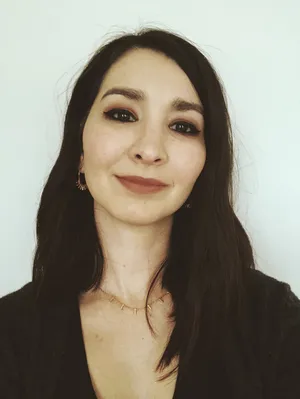Connecting Students Across Oceans for a Shared, Sustainable Future
Students from the U.S., France, and French overseas regions are working together with the support of the Smithsonian and the U.S. Embassy in France to focus on fostering a sustainable future for all.
:focal(960x539:961x540)/https://tf-cmsv2-smithsonianmag-media.s3.amazonaws.com/filer_public/3f/7e/3f7e01ed-0c7e-4c7e-bdff-9d81f73354bd/alma.png)
The Embassy of the United States of America in France and the Smithsonian Institution (Office of International Relations, Smithsonian Science Education Center, and Earth Optimism) have developed a unique program that allows students, educators, and professionals to reach across the globe to explore and discuss new approaches for living, learning, and working more inclusively and sustainably.
In spring 2021, the #SmithsonianInFrance program launched with a five-part virtual speaker series devoted to exchange between museum professionals, NGO leaders, cultural sector professionals, sustainability experts, and others in the U.S. and France. Experts from both countries introduced topics that included race, inclusivity, climate change, and sustainability (you can watch these recorded sessions on the Embassy’s YouTube playlist). The Embassy and Smithsonian teams took inspiration from this speaker series to develop an exchange program for approximately 850 students and educators from the U.S., France, and French overseas regions using the Smithsonian Science Education Center’s Sustainable Communities! How will we help our communities thrive? research guide. This guide is a part of the Smithsonian Science for Global Goals project.
To facilitate the virtual exchange, the Smithsonian and the Embassy used the eTwinning platform. This tool enabled student groups to collaborate and interact across borders in between “live” sessions hosted by the Smithsonian. Together they explored topics about their own communities and those of their peers, investigated their personal sustainability habits, and identified ways that they could improve and foster sustainability.
A cohort of students then developed their own “capstone” projects, implementing what they’ve learned during the programming and collaborative learning sessions to take action in their own communities. Students explored everything from the impact of planting native species to how to create an app that provides rewards to people who commute by bicycle.
Heidi Gibson, Science Curriculum Developer for the Smithsonian Science Education Center, shared how these outstanding sustainable project ideas emerged from the exchange: “This program demonstrates that when given the time and tools, young people are excellent at reflecting on aspects of sustainability in their own lives and in their communities. And they are ready to turn those reflections into actions, changing daily habits as well as working towards broader systemic change. To me, it is an illustration of the power of young people to take action when given the opportunity and encouragement from their teachers and peers.”
Reaching across an ocean to learn together, particularly during a global pandemic, is an incredibly valuable experience for the students, educators, and professionals who are a part of this program. For the students, in particular, learning through this dynamic approach allows them to explore ideas and actions in a way that they might not experience in a traditional classroom setting. “Smithsonian Science for Global Goals helps students discover how global issues are impacting their local community, understand the root causes of these issues including the science and social science behind them, and act to engage and make change in their own communities,” said Dr. Carol O’Donnell, Director of the Smithsonian Science Education Center. “We are so pleased to be a part of this project that inspires students to connect across borders on issues of sustainability.”
Additionally, this program came at a pivotal moment for the U.S. and France. #SmithsonianInFrance launched shortly after President Biden signed an executive order to rejoin the Paris Climate Accords just hours after taking office, reaffirming the nation’s commitment to this international treaty and creating climate solutions. U.S. Ambassador to the Republic of France and the Principality of Monaco, Denise Campbell Bauer, echoed the value of a French-American relationship during this turning point for international climate goals, "The U.S. is deeply committed to combating climate change and empowering tomorrow’s leaders to become part of the solution. By bringing young American and French people together through this virtual classroom exchange, they learned how they can work together to achieve our shared climate goals. Combatting climate change is a global problem that requires global solutions."
The Smithsonian Institution also feels a call to engage in solutions-focused dialogue and commitments. “As the United States’ national museums, we have a responsibility to engage on the pressing global challenges of our time – from climate change to public health to issues of diversity, equity, access, and inclusion – the solutions to which require an international vision and perspective. We have much to share with and learn from colleagues around the world as we tackle these challenges together, “ says Liz Tunick, Manager, Global Cultural Sustainability Program in Smithsonian’s Office of International Relations, emphasizing the value of programs like #SmithsonianInFrance during this important moment in time.
Tunick also shared the importance of working internationally with the support of the Embassy to help shift focus to a globally encompassing view, “Our museums and programs confront contemporary topics related to culture and science, but they also investigate history and the past, seeking to understand how humans and nature have shaped and been shaped by one another. We can’t do that without understanding the diverse perspectives of colleagues and individuals worldwide. Exchanges and working with and through partners is critical to achieving the global impact we aim to have.”
Stay tuned as we share more about #SmithsonianInFrance through first-hand stories from teachers, students, and the team behind the program. As they share what they’ve gained from the program and key takeaways, you’ll understand more about how this style of virtual exchange and learning works and how cross-cultural conversations empower professionals and students to create a more sustainable future for our organizations, communities, and planet.
If you are an educator and would like to learn more about how your classroom can participate in similar programs, email Katherine P. Blanchard at [email protected].

